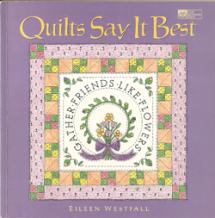
ISBN 1-56477-179-2
Bogens forfatter ynder at flette tekst ind i quilts, f.eks.:
”I never met a quilter, I didn’t like!”
”Man may work from sun to sun – but woman’s patchwork is never done!”
og hun beskriver grundigt fremgangsmåder på quilts af den art. Bogen indeholder mønstre i fuld størrelse og anvisning på, hvorledes der skal skæres og sys. De gengivne quilts er tegnede/malede udkast.
En sød lille bog med overkommelige quilte-projekter.
Gerda Helene Jepsen. Boganmeldelse i Kludemagasinet 3/1997
Tilføjet 2009 af Liselotte Kannik-Marquardsen:
Historie ved forfatteren:
Baltimore Album Style quilts are based on ornately appliquéd quilts made in the Baltimore, Maryland, area in the mid-1800s. These quilts feature baskets and vases overflowing with flowers; Wreaths of roses, acorns, and strawberries; folk art-style red-and-green quilt blocks; and ornate picture blocks. Most of the antique Baltimore Album quilts seem to be the combined effort of many women donating appliquéd blocks to commemorate a special occasion or to honor a certain person. Delicate inked signatures may indicate the stitcher or donor of a particular block. The artists often included special sayings or remembrances, embellished with scrolls and garlands, for the lucky recipient of such a gift.
Antique Baltimore Album quilts share certain themes and Victorian-era symbols. Bouquets were artfully arranged using the language of flowers, similar to the way a Victorian lady would arrange a bouquet of real flowers. White roses, representing purity and grace, were often a prominent part of a block design. A red book or album may have been modeled af-ter popular album books, inside which a Victorian lady kept cherished mementos. Eagle designs displayed a lady’s patriotism, while other birds and small animals showed her lov of nature. Monuments, manor houses, and ships were often focal points, meant to com-memorate special events or areas of interest in the city of Baltimore. Close inspection of the block designs reveals something special about each artist.
All types of fabrics, including cotton, velvet, silk, and wool were used in Baltimore Album quilts. Many of these quilts include dimensional techniques, such as stuffed flower petals and grapes, ruched roses, and embroidered accents on leaves and buds. I have found no mention of silk-ribbon embroidery in my study of antique Baltimore Album quilts, although it was in practice at the time. I have found several references to ornamental needlework, which includes silk-ribbon embroidery. Typically, these were projects for teaching young women advanced needlework. The examples I have seen are amazingly similar in style to Baltimore Album Blocks.
In creating my miniature block designs, I tried to honor the original Baltimore Album de-signs, incorporating many of the techniques as well as the style of these quilts

